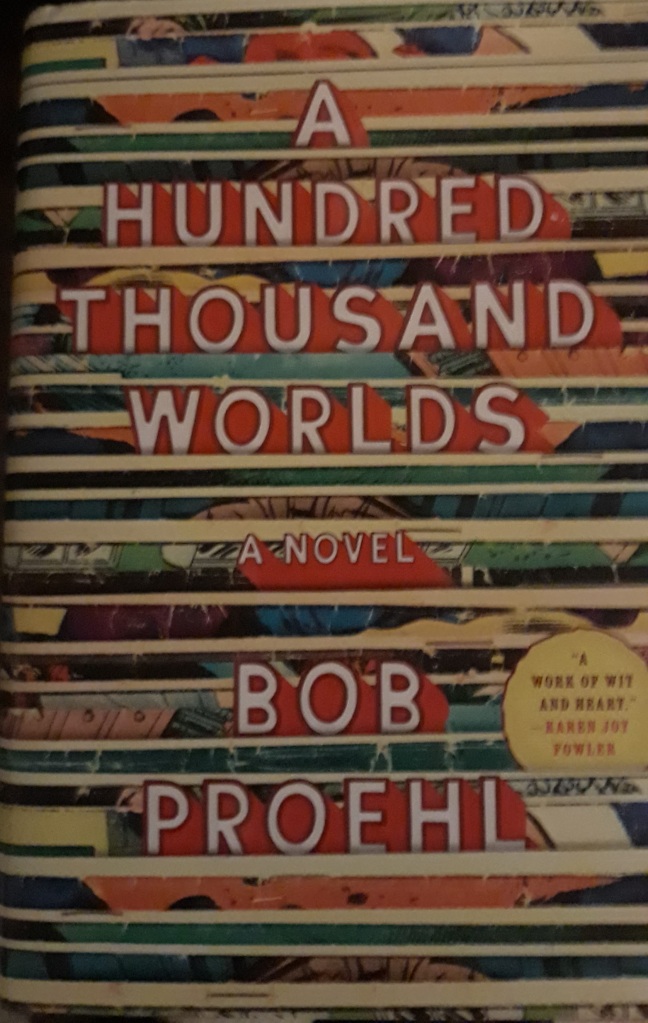
A Hundred Thousand Worlds
Bob Proehl
Viking 2016
Bob Proehl is a smart guy. (And I don’t say that because as I read his book A Hundred Thousand Worlds, it became clear to me that Mr. Proehl had probably read the same indy comics, bulletin boards, and comics blogs that I did in the early 2000s). Of course, I managed to turn that experience into a couple of long boxes in my basement, while Bob has written an structurally interesting and heartfelt book about how we love the media we love and how audience, creator, and product blur in a world of instagram, twitter, and youtube.
But that’s not why I think Bob Proehl is smart. He’s smart because he realized the narrative possibilities of a road trip to comic conventions: the action in his book starts at a small convention (Ohio) moves to a larger one (Chicago) and ends up at the largest (Los Angeles). The part of me that worries about emails from comic book fans wants to point out that these are fictional comic conventions that’s why its LA and not San Diego. But I’m trying to avoid these sorts of digressions that would be footnoted in caption boxes by editors in comic books.
The book’s main character is Vickie Torry. Vickie was the star of a beloved time travel show (Anomaly) whose fan base is still rabid enough that Vickie is road tripping from NYC to LA and getting paid for photo opportunities at comic book conventions. This is not Vickie’s normal sort of gig–in fact she’s mostly been doing theater in New York since her show went off the air. Her travelling companion is her son, Alex, who is introduced in the following manner:
“Alex Torrey, nine but small for his age, writes the names of the places on the exit signs in his notebook. Below each, he rewrites the name backwards. He reads them aloud, quietly, so his mother can’t hear him over the radio. Collections of random syllables. Impossible strings of consonants.
It’s tough work. But finding a magic word ought to be. There are useless abracadabras and hocus-poci lying around everywhere but ones that still have magic in them, that haven’t had it all sucked out, are harder to find.”
At the conventions, we meet a variety of folks: There’s a bevy of ladies who are paid to cosplay (I used to have a gloss for cosplay here, but we all know what cosplay is right? It’s a portmanteau word of costume and play, if that helps.) comic books characters and work the convention taking pictures with the fans. There’s also a bunch of comic creators: a female writer who got her start writing comics staring Vickie’s character from the TV show; a couple of her male comic book writers friends who are living the dream of writing some if the best known comic book heroes; and there’s Brett and Fred who produce an independent, space opera comic book starring a gender nonconforming space travelling cabaret singer called Lady Stardust. (If you think that seems like a commercial non started, you obviously weren’t at SPX festival in the early 2000s.)
Here’s a description of one Lady Stardust’s panels: “A panel from issue eleven. Lady Stardust, transvestite transplanetary cabaret starlet. Standing behind her lover, David, currently incarnated as a mute clown named Beep Beep. One of her hands points a ray gun over his shoulder and directly at the reader. The other is down the front of his pants. All seen through the ragged bloody hole she’s shot through an alien mobster’s head.”
And no that is not an absurd concept for an independent comic book. I believe the title of World’s Most successful indy comic was about a group of teenage human turtle hybrids named after Renaissance artists who fought crime and alien invaders with martial arts. Lady Stardust is in perfect company.
The story is structured around what happens at the convention, but also around Vickie’s retelling of the episodes of her show to her son as bedtime stories. Her son is also writing a story based on the prompt he got from the mysterious idea man. Brett is roped into drawing parts of the story by Alex and eventually Brett hooks up with the young woman who cosplays as Ferret Lass. The story involves a ton of moving pieces, but Proehl manages them well and produces a book that provides insights into fan culture, the downsides of being famous, and how tragedy can ripple through folk’s lives.
Also if you have any questions about how much you’ll like this book I would let you know that Bob Proehl created a comicbook character named Ferret Lass who no doubt has the powers of both a Ferret and a Lass.
